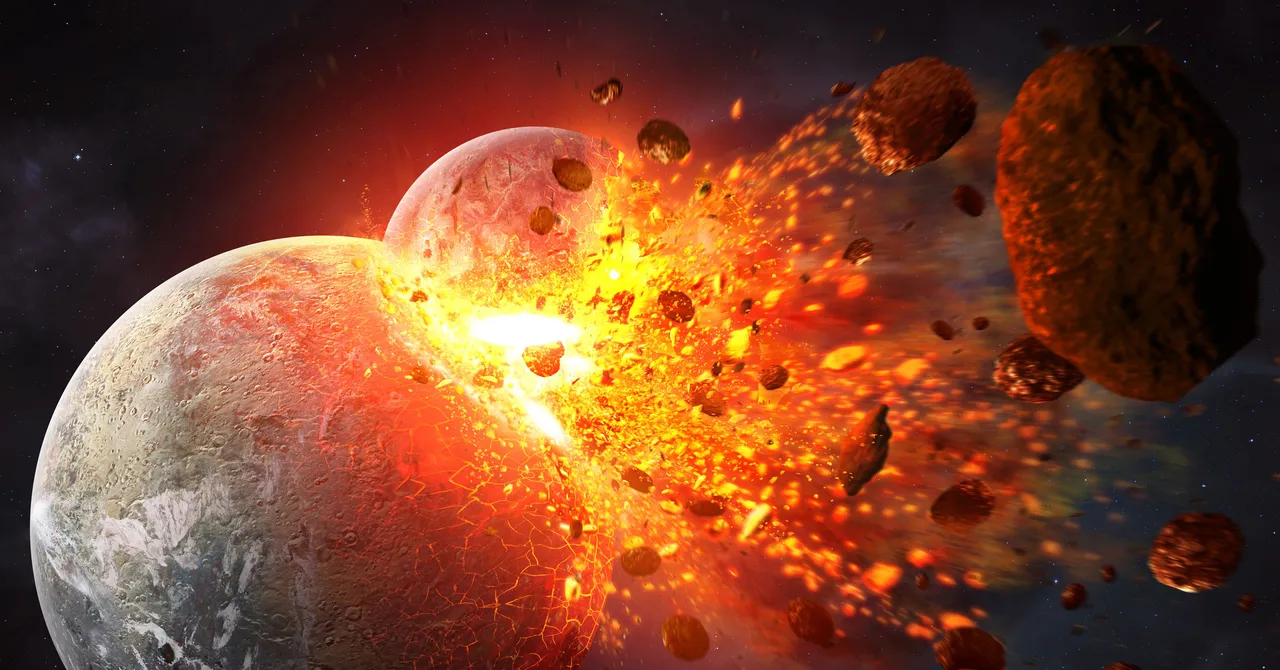
the Earth you walk on today might not be the same planet that was born 4.5 billion years ago. Many scientists believe that in its infancy, Earth collided with another world the size of Mars, and that instead of being destroyed, it was transformed, incorporating the mass of that foreign body to become the planet we know. Recent research adds another layer of relevance to that hypothesized cosmic event: Scientists believe that without that other body, the basic conditions for life to emerge on Earth might never have appeared.
A team from the University of Bern in Switzerland argues that, due to its proximity to the sun, the proto-Earth that existed before this potential collision lost the volatile elements essential to form complex molecules. Any hydrogen, carbon, or sulfur, their analysis suggests, evaporated in just the first 3 million years after proto-Earth’s formation. And so if Earth had evolved without external inputs, they say, it would probably be a drier world, more hostile to the development of complex life.
On the other hand, if a body formed in the outskirts of the solar system—a region that produces rocks with abundant water and other volatile elements—and this then hit a rocky planet like proto-Earth, then this could have provided the strange chemical richness that characterizes our planet today, even after Earth’s initial aggressive evaporation process. This hypothesis coincides with other proposals that point to an extraterrestrial origin of water, according to which icy meteorites bombarded the primitive Earth and deposited their molecules.
In a study published in Science Advances, researchers precisely measured the radioactive decay of two isotopes, manganese-53 to chromium-53, in both terrestrial samples and meteorite fragments found on Earth. Since these space rocks formed at the same time as the sun and the solar system’s planets, analyzing traces of them and their composition is equivalent to opening a time capsule from the past. By calculating the radioactive decay of manganese-53, the researchers revealed the point in time when the planets stopped exchanging material with their environment and fixed the chemical elements they would keep forever.
Their results show that proto-Earth sealed its elements just 3 million years after the birth of the solar system. Moreover, they found that the early planet’s ratio of manganese to chromium was very low, suggesting that proto-Earth was an extremely hot world, capable of expelling manganese. Since this element is less volatile than other more important elements, such as hydrogen, carbon, or sulfur, these too must have escaped.
“Thanks to our results, we know that the proto-Earth was initially a dry rocky planet. It can therefore be assumed that it was only the collision with Theia that brought volatile elements to Earth and ultimately made life possible there,” Pascal Kruttasch, first author of the report, said in a University of Bern press release.
Theia is the name of the hypothetical body thought to have hit proto-Earth about 4.5 billion years ago. The researchers believe the impact would have occurred between 30 and 100 million years after the beginning of the solar system—that is, several tens of millions of years after the ancestor of our planet was known to be a very dry world.
However, the arrival of water and other volatile elements does not equate to the immediate emergence of life. Water alone does not produce life, but it does create a much more favorable chemical and physical environment for other molecules to appear and, with them, the biological processes that underlie cells. In this sense, Theia set the stage but did not ignite the spark.
This story originally appeared on WIRED en Español and has been translated from Spanish.
Read More
Scientists Have Identified the Origin of an Extraordinarily Powerful Outer-Space Radio Wave
In March 2025, Earth was hit by a fast radio burst as energetic as the sun but lasting only milliseconds.
A Super-Energetic Neutrino That Reached Earth in 2023 Has Been Confirmed to Be Real. But Where Did It Come From?
Two years ago, Earth was hit by the most energetic neutrino in history. Scientists thought it might be a measurement error, but a new study has confirmed this “ghost particle” was real.
Scientists Find a New Moon Orbiting Uranus
The provisionally named S/2025 U1 is so small it had gone unnoticed by probes and telescopes for the past 40 years.
These Newly Discovered Cells Breathe in Two Ways
In a hot spring at Yellowstone National Park, a microbe does something that life shouldn’t be able to: It breathes oxygen and sulfur at the same time.
This Giant Subterranean Neutrino Detector Is Taking On the Mysteries of Physics
Located in China, Juno is a 17-country collaboration that will try to detect neutrinos and antineutrinos to learn more about their mass.
IBM and NASA Develop a Digital Twin of the Sun to Predict Future Solar Storms
The tool models the sun using AI, and its developers say it can anticipate solar flares 16 percent more accurately and in half the time of current prediction systems.
Extreme Heat Makes Your Body Age Faster
A study reveals that extreme heat accelerates biological aging even more than smoking or drinking.
NASA’s Largest Satellite Antenna Ever Has Just Unfurled in Space
NISAR, a giant orbiting antenna 39 feet in diameter, will monitor changes to glaciers, forests, and the Earth’s crust, providing data to help improve infrastructure and disaster responses.
Antarctica Is Changing Rapidly. The Consequences Could Be Dire
“Abrupt changes” threaten to send the continent past the point of no return, at which point continued ice-melting would submerge coastal cities around the world.
SpaceX Starship Finally Pulls Off a Successful Test Flight
After being postponed twice—and after multiple failed attempts—Starship’s 10th test flight was a success.
This Is the First Time Scientists Have Seen Decisionmaking in a Brain
Twelve laboratories around the world have joined forces to map neuronal activity in a mouse’s brain as it makes decisions.
Hungry Worms Could Help Solve Plastic Pollution
Researchers are working on manipulating the digestive systems of wax worms to create a scalable way of disposing of plastic.



